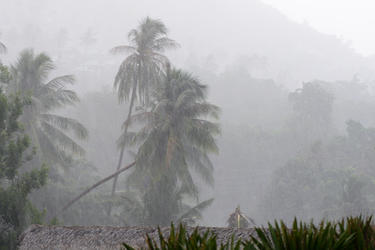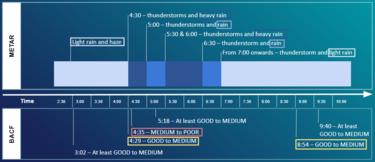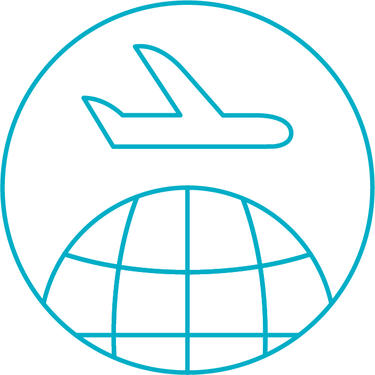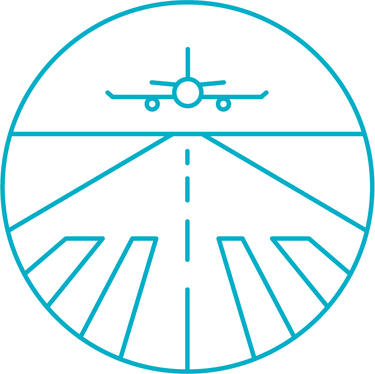Every year ahead of the monsoon in the South-South East Asia region, several airports prepare their runways for the heavy rains they experience from June onward. The monsoon season is a great challenge for airports especially for the ones where domestic traffic is picking back up post Covid-19.
The weather conditions during the monsoon season can significantly affect the safety of the operations as well as the operating costs. The monsoon, which is characterized by frequent and significant episodes of thunderstorms and heavy rain, has an impact on visibility, wind conditions and runway conditions. In case of sudden and dense rainfall and insufficient drainage, water might accumulate and operating areas of the airports might even be overflowing with water. This is what was reported by the Delhi International Airport Limited (DIAL) on Twitter in September 2021 "due to sudden heavy rain, for a short period, there was waterlogging at the forecourt".
Facing the monsoon season

It is projected that the monsoon weather episodes will be even more challenging in the future.
The research article “Robust increase of Indian monsoon rainfall and its variability under future warming in CMIP6 models” (Katzenberger, Schewe, Pongratz & Levermann, 2021), highlights the following:
“The projected increase in summer monsoon rainfall in combination with the projected long-term increase in interannual variability will be accompanied by an increased number of extremely wet years and potentially more high-rainfall events”.
NAVBLUE, airline operators and the airport can join their efforts in increasing the runway condition awareness with RunwaySense.
RunwaySense is a collaborative web-based platform where airspace users share runway condition reports in real-time to enhance the runway condition awareness, and to allow the airport to anticipate and mitigate slippery conditions. RunwaySense uses unique data from A320 and A330 family aircraft provided by the Braking Action Computation Function “BACF” to accurately report the condition of the runway it has just landed on against the FAA’s Take-off and Landing Performance Assessment (TALPA) Runway Condition Assessment Matrix (RCAM). RunwaySense data is compliant with the ICAO Global Reporting Format “GRF” which came into effect on November 4, 2021.
| | | |
1,600+ aircraftcommitted to install BACF and more than 1,200 aircraft already flying with BACF | 35,000+ BACF-ACARS messages35,000 BACF-ACARS messages received globally per month | 20+ airportshave already subscribed to the RunwaySense Service |
BACF provides 2 types of measurements
- Friction limited measurements are generated when the braking force is friction limited mainly in case slippery conditions are encountered on the runway and this whatever the cause of the slipperiness (e.g. ice, snow, water, rubber, sand among others). This type of measurement is made available to the flight crew in the cockpit a few seconds after the landings so that it can be used for the Pilot Report of Braking Action.
- Non-friction limited measurements are issued when the braking force that is reached is in line with the commanded level of braking. In these cases, BACF identifies the braking action on the runway is equal or better than a given braking action level.
2021 South-South East Asia monsoon highlights
In 2021, 6 different airlines issued BACF reports in South-South East Asia.
Today we count more than 200 BACF-equipped aircraft being operated by these airlines that subscribed to the RunwaySense Service.
On 30th October 2021,
the Government of India Ministry of Earth Sciences India Meteorological Department (IMD) published a press release "Salient Features of Monsoon 2021" which explains the following:
"Considering month to month rainfall variation over India as a whole, the season is very uniquely placed in the historical record for its distinct and contrasting month to month variation. The rainfall over the country as a whole was 110%, 93%, 76% and 135% of Long Period Average “LPA” during June, July, August and September respectively. The IMD defines the LPA of rainfall as being the "rainfall recorded over a particular region for a given interval (like month or season) averaged over a long period like 30 years, 50 years etc".
It is interesting to note that there is a direct correlation between the monsoon season and the rainfall figures reported by the IMD on one side and the rate of BACF friction limited measurements on the other side:
In June 2021 | The usual starting month for the monsoon season, the IMD reported that the rainfall over the country was 110% of the LPA whereas we observed an increase of 60% |
In July 2021 | the IMD reported that the rainfall over the country was 93% of the LPA whereas we observed a slight decrease of 7% of the rate of BACF friction limited measurements from June to July 2021. |
In August 2021 | The IMD reported that the rainfall over the country was 76% of the LPA whereas we observed a decrease of 60% of the rate of BACF friction limited measurements from July to August 2021. |
In September 2021 | The IMD reported that the rainfall over the country was 135% of the LPA whereas we observed an increase of 60% of the rate of BACF friction limited measurements from August to September 2021. |
The highest rates of BACF friction limited measurements were observed in June and in September, the same months where the IMD reported the highest percentage of rainfall. This observation tends to show the effectiveness of BACF in detecting slippery conditions in case of heavy rainfall.
Practical example of correlation between the weather conditions evolution and the reports collected from BACF
At a given airport and on a given day during the monsoon season of 2021, the METAR data were correlated with the BACF reports. At this airport, during the whole day, the reported temperature was oscillating between 26°C and 28°C.
- METAR - From 0:00 UTC to 4:30 UTC, light intensity rain and haze were reported.
- BACF - At 3:02 UTC, a “non-friction limited” BACF report was generated further to the landing of a BACF equipped aircraft. BACF reported that the braking action was “at least GOOD TO MEDIUM” on a 200 meters length portion of the runway.
- METAR - From 4:30 UTC, thunderstorms with heavy rain were reported.
The degradation of the weather conditions consequently led to the degradation of the braking action level measured by BACF. 2 consecutive “friction limited” reports were collected.
- BACF - At 4:29 UTC, BACF reported that the braking action was “GOOD TO MEDIUM” over a portion of about 200 meters length.
- BACF - At 4:35 UTC, BACF reported that the braking action was “MEDIUM TO POOR” over a portion of about 100 meters length. As per the ICAO RCAM (Runway Condition Assessment Matrix), a “MEDIUM TO POOR” braking action corresponds to the following criteria in terms of runway surface description: “More than 3mm depth of water: standing water”.
- METAR - At 5:00 UTC, the METAR showed thunderstorms and rain instead of heavy rain (as previously reported).

- BACF - At 5:18 UTC, BACF reported a braking action “At least GOOD TO MEDIUM” over a distance of about 300 meters.
- METAR - At 5:30 UTC and 6:00 UTC, thunderstorms and heavy rain were reported again associated with gusting wind up to 16 knots.
At 6:12 UTC a BACF equipped aircraft landed without generating any BACF report. The absence of report might be due to a low commanded braking force or might be linked to the improvement of the weather conditions as reported in the subsequent METARs.
- METAR - From 6:30 UTC and until 9:00 UTC thunderstorms were still present but associated with light rain.
- BACF - The next BACF report that was generated reported a braking action “GOOD TO MEDIUM” at 8:54 UTC.
- METAR - From 9:30 UTC onward, rain and light rain were reported without any further weather event to be highlighted.
- BACF - All BACF reports that were received during the rest of the day highlighted a braking action “at least GOOD TO MEDIUM”.
What are the benefits of RunwaySense while facing the monsoon season?
During the monsoon preparation phase
The BACF data can contribute to gaining a more robust and accurate understanding of the actual runway condition with regards to its effect on the aircraft braking performance.
The granularity of the BACF measurements (down to 100 meters length) can help identify some specific sub-portions of the runway that might be more specifically subject to slippery conditions under certain conditions. This might help focusing the maintenance work on some specific areas of the runway.
During the monsoon period
BACF provides real time information about the runway condition without interfering with the airport traffic. The more aircraft equipped with BACF, the more frequent the BACF reports are and ultimately, the more accurate the picture about the runway condition evolution is at any point in time.
In case of sudden degradation of the weather conditions, the airport awareness of slippery conditions caused by standing water will be enhanced. And on the contrary, the airport will also gain visibility in case the runway condition is improving which will contribute to increase runways availability as well as reduce potential delays and diversions.
Master Class:
NAVBLUE will be pleased to organize a new Master Class about RunwaySense in the course of September. During the Master Class you will learn more about the RunwaySense and how it can assist airports in monitoring runway conditions and targeting their runway clearing activities.
In the meantime, for more information, please contact us: runwaysense@navblue.aero



